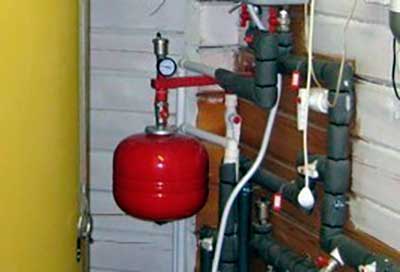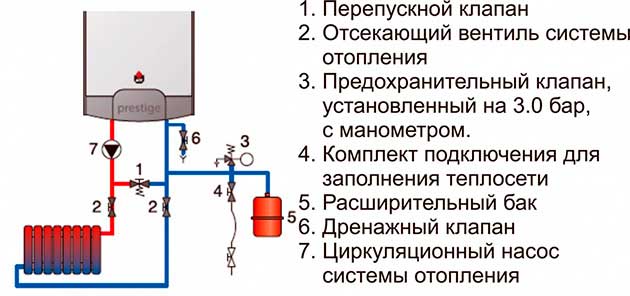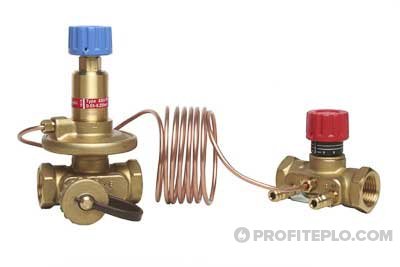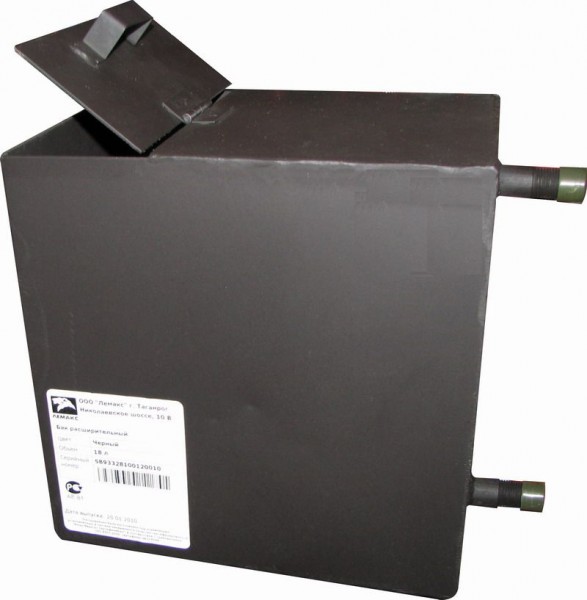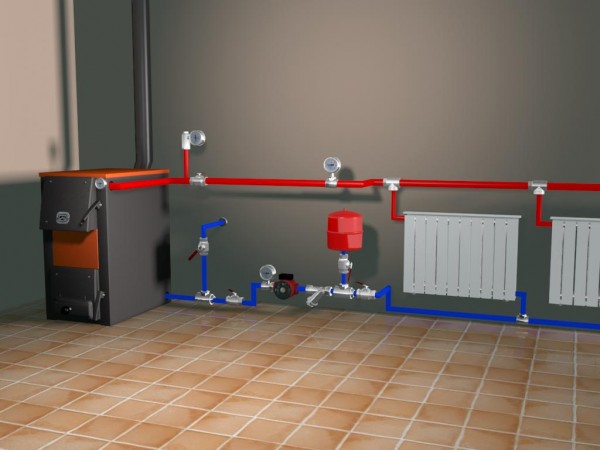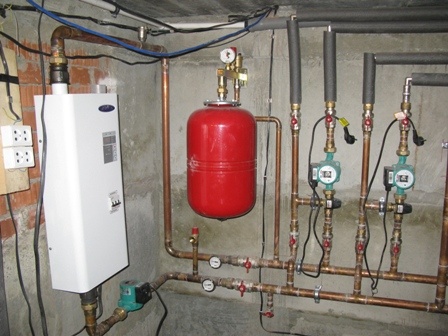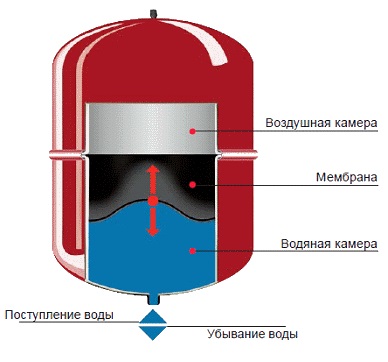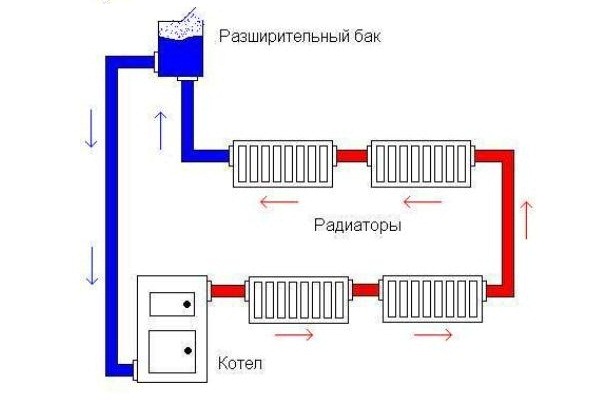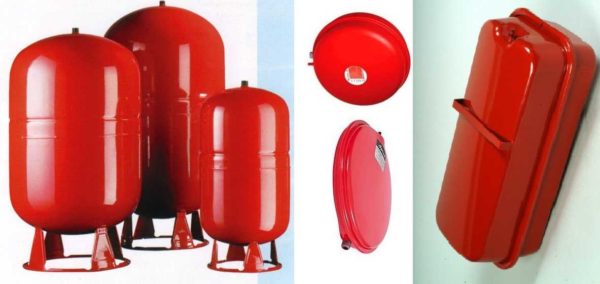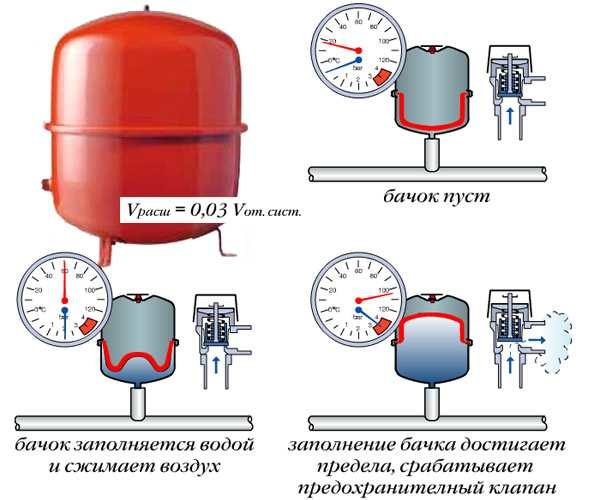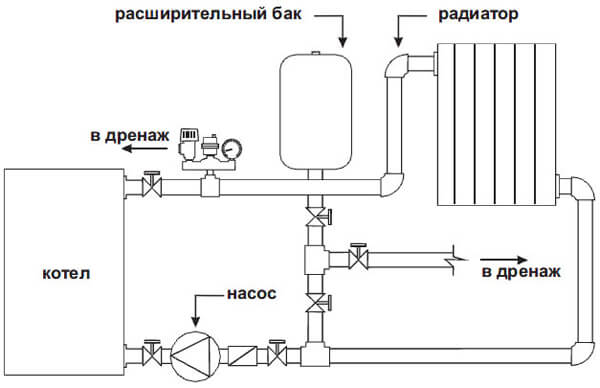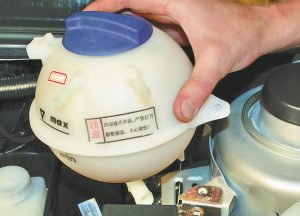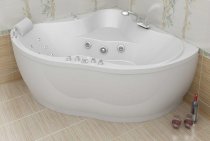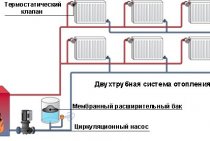Expansion tank installation process
Now let's figure out how to install an expansion tank in the heating system
There is an important rule for connecting the device: the tank must be connected to the heating system mains using a shut-off ball valve with an American. This installation principle makes it possible, if necessary, to block the movement of water in the system at any time, remove the faulty membrane tank and install a new one.
Otherwise, it would be necessary to wait for the coolant to cool down and dismantle part of the piping. Ideally, a tee is installed on the liner, as well as a second tap - in this case, before removing the expansion tank, it can be emptied into a substituted container.
How to correctly orient the membrane expansion tank in space? The tank is installed with the air chamber up or down, the tank is placed “on its side”. From the point of view of performance, this does not really matter, since in any case the device will perform its functions properly.
However, it is worth considering such a moment: if the air compartment is located below, then the coolant is supplied from above, and the bubbles of air dissolved in it will rise into the pipeline and be removed using an air valve. Otherwise, an air bubble will form in the "water" compartment of the membrane tank over time.
In turn, when the tank is located with the air chamber up, its service life is extended. Over time, from constant contact with hot water, the polymer membrane loses its tightness, cracks appear in it. If the air chamber is located at the bottom, then water immediately begins to seep into the air compartment, which will quickly disable the expansion tank, while air will penetrate into the coolant. When the air chamber is located on top, the diffusion of water through the cracks is many times slower, and the device is able to work much longer.
- If you install a pressure gauge next to the expansion tank and the valve, which feeds the heating system from the water supply, it will allow you to control the pressure in the system in order to bleed the excess in time if the safety valve spool is stuck and does not work automatically.
- The frequently repeated release of pressure by the valve indicates that the capacity of the expansion tank has been selected incorrectly. Instead of changing it to a larger tank, it is enough to connect a second tank in parallel.
- Replacing the existing expansion tank with a larger one or connecting a second one will also be required if it is decided to replace the water in the system with antifreeze. This is due to the fact that non-freezing coolants have a higher coefficient of thermal expansion.
Before connecting the tank and filling it with coolant, you need to check the pressure level in the air chamber of the tank - it must correspond to the pressure in the heating system. To do this, remove or unscrew the plastic plug that closes the spool (similar to those installed in car chambers). Using a manometer, it is necessary to measure the pressure and adjust it to the indicators of the heating system. To do this, air is pumped up by the pump or vice versa, it is bled by pressing the spool rod.
Note! The tank should be set in such a way that the pressure in its air chamber is 0.2 bar less than the calculated pressure in the system filled with coolant. If the pear-shaped membrane is not pressed from the water injection side, the coolant, shrinking during cooling, will be able to draw air through automatic air vents
After completing the settings, open the tap and fill the entire system with coolant. Then the boiler unit is started.
The adjustment step is not required if the factory pressure in the air compartment of the expansion vessel is correct. Manufacturers of some brands of equipment indicate the level of pressure in the tank on the packaging, which makes it possible to choose the option that will be optimal when buying.
Conclusion
You can install the expansion tank correctly, prepare a customizable membrane tank for work yourself, without the help of a specialist. The experience gained can be useful in the future if you need to quickly identify the source of problems associated with a decrease or surge in pressure in the system, due to which the burner flame goes out. In such cases, it is recommended first of all to carefully inspect the system for coolant leaks and measure the pressure in the air chamber of the membrane tank.
How and where is the expansion tank placed
So, we are going to design and assemble a heating system with our own hands. If she also earns - our joy will not be the limit. Are there any instructions for installing the expansion tank?
open system
In this case, simple common sense will prompt the answer.
An open heating system is, in essence, one large vessel of complex shape with specific convection currents in it.
The installation of the boiler and heating appliances in it, as well as the installation of pipelines, must ensure two things:
- Rapid rise of the water heated by the boiler to the upper point of the heating system and its discharge through the heating devices by gravity;
- The unhindered movement of air bubbles to wherever they rush in any vessel with any liquid. Up.
- The installation of a heating expansion tank in an open system is always carried out at its highest point. Most often - at the top of the accelerating manifold of a single-pipe system. In the case of top filling houses (although you hardly have to design them), at the top filling point in the attic.
- The tank itself for an open system does not need shutoff valves, a rubber membrane, and even a lid (except to protect it from debris). This is a simple water tank open on top, into which you can always add a bucket of water to replace the evaporated one. The price of such a product is equal to the cost of several welding electrodes and a square meter of steel sheet 3-4 mm thick.
It looks like an expansion tank for an open heating system. If desired, a water tap from the water supply can be brought into the hatch in it. But much more often, as the water evaporates, it is topped up with an ordinary bucket.
closed system
Here, both the choice of the tank and its installation will have to be taken quite seriously.
Let's collect and systematize the basic information available on thematic resources.
The installation of the expansion tank of the heating system is optimal in the place where the water flow is closest to laminar, where there is a minimum of turbulence in the heating system. The most obvious solution is to place it in a straight dispensing area in front of the circulation pump. At the same time, the height relative to the floor or the boiler does not matter: the purpose of the tank is to compensate for thermal expansion and dampen water hammer, and we perfectly bleed air through air valves.
Typical tank setup. Its location in a single-pipe system will be the same - in front of the pump along the water course.
- Tanks in the factory are sometimes supplied with a safety valve that relieves excess pressure. However, it is better to play it safe and make sure that your product has it. If not, buy and mount next to the tank.
- Electric and gas boilers with electronic thermostats are often supplied with a built-in circulation pump and a heating expansion tank.Before you go shopping, make sure you need them.
- The fundamental difference between membrane expansion tanks and those used in open systems is their orientation in space. Ideally, the coolant should enter the tank from above. This subtlety of installation is designed to completely remove air from the compartment of the tank that is intended for liquid.
- The minimum volume of the expansion tank for a water heating system is taken approximately equal to 1/10 of the volume of the coolant in the system. More is acceptable. Less is dangerous. The volume of water in the heating system can be roughly calculated based on the heat output of the boiler: as a rule, 15 liters of coolant per kilowatt are taken.
- A pressure gauge mounted next to the expansion tank and the make-up valve (connecting the heating to the water supply) can provide you with an invaluable service. The situation with a stuck spool of the safety valve, alas, is not so rare.
- If the valve relieves pressure too often, this is a clear sign that you miscalculated with the volume of the expansion tank. It is not necessary to change it at all. It is enough to purchase another one and connect it in parallel.
- Water has a relatively low coefficient of thermal expansion. If you switch from it to a non-freezing coolant (for example, ethylene glycol), you will again need to increase the volume of the expansion tank or install an additional one.
The expansion tank in the photo is mounted in accordance with all the rules: the coolant is connected from above, the tank is equipped with a pressure gauge and a safety valve.
Comparison of closed and open heating systems
The functioning of an open heating system is based on the laws of thermodynamics, due to which the movement of the coolant is carried out. From the area of high pressure and the corresponding temperature at the boiler outlet, the water moves through pipes to the area of lower pressure, and its temperature decreases. The cooled coolant is sent back to the boiler, and the process is repeated. Thus, there is a natural circulation of the liquid, according to the laws of physics.
Since when water is heated, its volume increases, an expansion tank is provided in the design of an open heating system. For efficient movement of an open-type coolant, the expansion tank is installed at the highest point of the system, and the heating boiler at the lowest. Installing an expansion tank in the attic seems to be the best option. Its device is not complicated.
Over time, water evaporates, so its level must be replenished in a timely manner. During interruptions in the use of heating and at negative ambient temperatures, the water must be drained, otherwise it will freeze in the pipes and break them. An open heating system has the following advantages:
- independence from sources of electrical energy;
- no noise;
- ease of maintenance;
- quick start and stop.
You can choose radiators for any type of heating system based on the recommendations of the article “Which radiators are better to choose for heating a private house: photos, dimensions and technical characteristics”.
In a closed heating system, water evaporation does not occur, since it is hermetic. The movement of the coolant is carried out using a pressure or circulation pump, which can be found in the article “Which circulation pump to choose for a private house water heating system, technical specifications”. At the same time, an expansion tank made of durable metal is also required for efficient operation. The closed heating system consists of a heating boiler, a circulation pump, a pipeline network, radiators and an expansion tank. A closed heating system has the following advantages:
- no need for constant monitoring of the coolant level;
- the possibility of using antifreeze;
- adjustment of internal pressure;
- the ability to connect additional devices.
Closed heating system
With proper installation of heating equipment, both options will work perfectly. The choice between them is determined by the operating conditions and placement features. There are the following differences between the two systems:
In an open heating system, the expansion tank is located at the highest point. In a closed heating system, it can be located almost anywhere.
The likelihood of air locks in a closed heating system is much lower. This is due to the increased internal pressure and the lack of direct contact with the atmosphere.
For the operation of an open heating system, pipes of large diameter are required. Installation work is complicated by the need to take into account the rules of hydraulics when distributing flows, making turns, slopes, and so on.
Small-diameter pipes used in a closed heating system reduce its cost
Here it is important to correctly install the circulation pump so that during its operation it creates as little noise as possible.
general information
What is an expansion tank and what is it for?
Its very name gives a hint: for an extension. With a fixed mass of the coolant in the heating circuit and pipes, the elasticity of which tends to zero, with a change in the temperature of the coolant, the pressure in the system will inevitably change. Thermal expansion, remember? Water or any other coolant, when heated, expands.
Once the force exceeds the tensile strength of the pipe or radiator... Boom!
The reason for a possible accident is that water, changing its volume when heated, remains practically incompressible. Hence the concept of water hammer: there are no elastic interactions in a liquid medium, to put it simply.
The obvious solution is to create a reservoir with an easily compressible substance, air, in the system. With an increase in the volume of water in the presence of such a reservoir, the pressure will increase slightly.
Useful: so that oxygen from the air tank does not contribute to the corrosion of pipes, dissolving in water, in tanks for closed systems it is separated from the water by a rubber membrane.
This is how this simple device looks like in a section.
However, we have described only one of the functions of the expansion tank.
In addition to closed heating systems of private houses with fixed volumes and a circuit and a coolant in it, an expansion tank can be found:
- In open systems in contact with atmospheric air;
- In central heating systems with top filling. There, the expansion tank is located in the attic and is connected directly to the supply pipeline of the house heating system.
In both cases described, the installation of an expansion heating tank is needed in order to get rid of air locks. The difference between the two threads in the case of central heating is only about two meters. In heating systems of private houses with natural circulation - even less.
Clarification: the author can still hear the exclamations of more or less knowledgeable people who, at the height of the heating season, saw a 10 times greater drop in the elevator unit. Typically 6 kgf / cm2 on the supply pipeline and 4 - on the return (1 atmosphere of overpressure corresponds to a water column of 10 meters). Do not confuse warm with soft: it is not water from the supply that enters the heating system, but a mixture. The elevator recirculates the return water through the heating system by injecting a jet of hotter water with a higher pressure from the supply pipeline into it through a nozzle. As a result, as stated, the difference between the mixture and the return flow does not exceed 2 meters, or 0.2 kgf / cm2.
With such a difference, the water pressure will not be able to squeeze out the air plug from the upper part of the heating system. Hence a simple solution: put some kind of container for collecting air where it will accumulate, and bleed it when the system is started. In the case of an open system, of course, no active actions are needed.
All the air in the system will be pushed up and into the expansion tank. In an open system, it will immediately reunite with the atmosphere. In a closed one, it will wait until the owner of the house opens the air valve.
Benefits of using enclosed appliances
- Small dimensions of the tank, easy installation and maintenance of the tank.
- Tightness (evaporation is excluded, water can be replaced with antifreeze).
- There is no danger of underfilling (overfilling), freezing.
- The accelerated heating, automatic regulation.
- Regulation of pressure surges.
- Slight temperature fluctuation at the boiler connection points.
- Heat losses are excluded.
- Addition, decrease in room temperature.
- Installation in a free place for access.
- Narrow diameter pipes - cheaper cost.
The main plus is versatility: it is possible to include a boiler, a convector heater, a warm floor, radiators of various configurations in the system.
Volume calculation
There is a very simple method for determining the volume of an expansion tank for heating: 10% of the volume of coolant in the system is calculated. You should have calculated it when developing the project. If these data are not available, you can determine the volume empirically - drain the coolant, and then fill in a new one, measuring it at the same time (put it through the meter). The second way is to calculate. Determine the volume of pipes in the system, add the volume of radiators. This will be the volume of the heating system. Here from this figure we find 10%.
Shape may vary
The second way to determine the volume of the expansion tank for heating is to calculate it using the formula. Here, too, the volume of the system will be required (indicated by the letter C), but other data will also be needed:
- the maximum pressure Pmax at which the system can operate (usually take the maximum pressure of the boiler);
- initial pressure Pmin - from which the system starts work (this is the pressure in the expansion tank, indicated in the passport);
- expansion coefficient of the coolant E (for water 0.04 or 0.05, for antifreezes indicated on the label, but usually in the range of 0.1-0.13);
Having all these values, we calculate the exact volume of the expansion tank for the heating system using the formula:
The formula for calculating the volume of an expansion tank for heating
The calculations are not very complicated, but is it worth messing with them? If the system is open type, the answer is unambiguous - no. The cost of the container does not depend very much on the volume, plus you can make it yourself.
Expansion tanks for closed-type heating are worth counting. Their price depends heavily on volume. But, in this case, it is still better to take it with a margin, since insufficient volume leads to rapid wear of the system or even to its failure.
If the boiler has an expansion tank, but its capacity is not enough for your system, put the second one. In total, they should give the required volume (the installation is no different).
What will cause the insufficient volume of the expansion tank
When heated, the coolant expands, its excess is in the expansion tank for heating. If all the excess does not fit, it is vented through the emergency pressure relief valve. That is, the coolant goes into the sewer.
The principle of operation in a graphic image
Then, when the temperature drops, the volume of the coolant decreases. But since there is already less of it in the system than it was, the pressure in the system drops. If the lack of volume is insignificant, such a decrease may not be critical, but if it is too small, the boiler may not work. This equipment has a lower pressure limit at which it is operable.When the lower limit is reached, the equipment is blocked. If you are at home at this time, you can correct the situation by adding a coolant. If you are not present, the system may unfreeze. By the way, working at the limit also does not lead to anything good - the equipment quickly fails. Therefore, it is better to play it safe and take a slightly larger volume.
Set the optimal pressure in the tank
Before connecting the expansion tank and filling it with coolant, it is necessary to set the optimum pressure in its air chamber corresponding to this parameter in the heating network. To perform this procedure, a plastic cover is removed from the air compartment, under which there is a nipple, the same as in automobile tires. The pressure measured by the pressure gauge is adjusted to the desired value by pumping with a pump or by bleeding when the nipple stem is pressed.
The optimum pressure in the tank is obtained by adjusting the internal pressure in a closed heating system downwards. This is done so that the rubber diaphragm is pressed from the side of the coolant. Otherwise, when it cools down, air will be drawn through the automatic vents, which should never be allowed. For example, if the internal pressure in the network is 1.2 atmospheres, then its optimal value in the expansion tank will be one atmosphere. After setting this value, you can open the tap and fill the system with coolant.
Design features
The purpose of the membrane expansion tank is that at all operating stages the device must maintain a balance between the pressure of both parts and, if necessary, level out excessive pressure or regulate its differences in the heating structure. Thus, the installation of a membrane expansion tank prevents the occurrence of increased loads in the heating circuit and in emergency situations in the event of a malfunction.
The device comes with a replaceable or non-replaceable membrane. In the first case, the coolant is completely in the capacity of the flexible membrane and cannot interact with the steel inner surface. All work related to the dismantling and subsequent installation of a new product is carried out through a bolted flange.
If you purchased a device with a fixed iris, it has a two-part internal cavity. In this case, a non-replaceable diaphragm membrane is used, which is rigidly fixed. A membrane tank for a heating system is selected directly for a specific heating structure, taking into account the amount of coolant. If the volume of the device turns out to be insufficient, then the consequences can be the most negative - cracks often appear and water can leak through the thread. In addition, often in the system the pressure drops below the permissible norm, as a result of which air enters the tank. Therefore, the choice of device must comply with the necessary design parameters (in more detail: “We make the selection of an expansion tank for heating“).
An expansion membrane tank for heating systems is used when creating a circulation of a closed-type coolant in order to compensate for its thermal expansion as a result of an increase or decrease in the temperature of the liquid, thereby preventing water hammer. In constant mode, both chambers of the device - water and gas - have the same pressure, which allows maintaining the tightness of the system. Such a device for an expansion tank of the heating system has been time-tested and recognized as the most practical.
The water circulating along the circuit does not contain aggressive gases and therefore corrosion will not render the tank unusable, which allows it to be operated for a long time.The pressure expansion device is placed in the boiler room, and for this reason there is no need to protect it from freezing.
Despite the fact that the selection of a tank for a heating structure is individual, one should not forget that:
- the initial pressure in the membrane tank for heat supply, connected to cold water supply, must exceed the static pressure in the system by 30-50 kPa;
- the device must have a spare amount of coolant to compensate for possible leaks.
To protect the system with a closed circuit and an expansion tank from too high pressure, safety valves are installed.
How to install a membrane-type expansion tank
A membrane tank is needed to protect the engineering system from water hammer and fully ensure its high-quality operation. After purchasing the equipment, you need to carefully consider how to install a membrane tank so that it works without failures. The hydraulic accumulator in the water supply performs several functions: it accumulates a supply of water, maintains the necessary pressure in the system, and serves as a reserve to reduce the frequency of turning the pump on and off.
Without installing a diaphragm tank, the life of the pump is significantly reduced. In a system provided with a hydraulic accumulator, water can be collected even when the electricity is turned off. During the first start of the pump, the water chamber of the tank is filled with water. The larger the volume of water in the tank, the smaller the air volume and the higher the pressure.
Having reached the set pressure indicator, which is necessary to turn off the pump, it automatically turns off. As soon as the pressure in the system drops to an acceptable level, the water supply will immediately turn on. A pressure gauge is installed on the accumulator to check the pressure. It is also necessary to set the required range of operation of the equipment.
Common faults
As a rule, most problems are not related to the capacity itself. Not so often there are cases when the tank itself cracks and starts to flow for no apparent reason. However, even taking into account the simple design, the cap of the expansion tank of the engine cooling system may well be the problematic part.
The valve built into the cover may fail. Also, insufficient sealing can occur due to deformation of the rubber ring. As a result of such malfunctions, the cover may begin to leak antifreeze, the system becomes airy, etc.
If the valve in the cover starts to work incorrectly, then in such a case, deviations in the operation of the internal combustion engine cooling system are inevitable. In addition to the formation of air pockets, this situation in some cases leads to a critical increase in pressure and rupture of the expansion tank. In such a situation, the tank must be replaced with a new one. It is not recommended to attempt to restore a damaged container by soldering cracks.
If we talk about the cover, its damage and defects, as well as malfunctions of the valves due to clogging or exhaustion, are the reason for replacing the cover. In some cases, the cover is cleaned in an attempt to restore functionality, but this method does not always work. Given the low cost, it is better to replace the element immediately.
